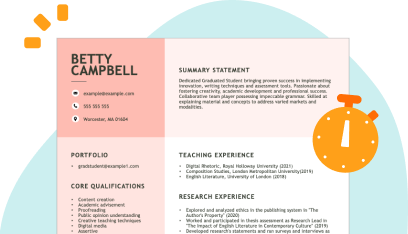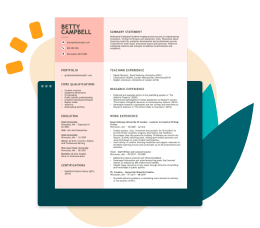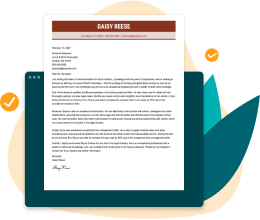Refined
Traditional Resume Templates
Our selection of traditional resume templates balance simplicity with structure, ensuring your experience and skills are presented in a polished, easy-to-read format that meets employers’ expectations. After you’ve picked the ideal template, tailor it to your most relevant qualifications and career achievements. Below, we provide a step-by-step guide to help you maximize the impact of each section and make your resume stand out.
What is a Traditional Resume Template?
A traditional resume template is a clean, straightforward layout designed to present your professional experience simply yet sophisticatedly. These templates focus on clarity and structure, using familiar sections like work history, education and skills that recruiters expect to see on your resume. Traditional resumes prioritize substance over style, making them reliable for industries that value professionalism and a no-frills approach. In this article, we’ll explore what makes a traditional resume template effective and how to use one to highlight your strengths to ultimately win a job.
Is a Traditional Resume Template Right for You?
Here are a few questions to consider before selecting a resume template:
What kind of image does my resume present to employers?
Your resume will often be the first impression on an employer, so make it count! Our traditional resume templates are a great fit if you want an intuitive, easy-to-read design that helps you appear straight-laced and professional. On the other hand, if you’re after something more contemporary or colorful, our modern templates may be a better fit.
What is the employer’s company culture?
The resume design you choose should reflect the company culture of your prospective employer. For example, when applying for a role at an accountancy firm, a more buttoned-up traditional resume template will help boost your chances of being hired. If you plan to apply for work at a graphic design firm or advertising agency, a creative template may be more suitable.
Will this resume template get past an ATS screening?
Our resume templates are designed to make it past applicant tracking systems (ATS). Our professional resume templates ensure ATS compliance by excluding images and overcomplicated designs that could confuse the software.
If you’ve decided a traditional resume template suits you, feel free to skip to our Resume Builder for a custom resume. With user-friendly design tools and content suggestions written by Certified Professional Resume Writers (CPRW), you’ll have a professional resume in minutes.
Introduce Yourself With a Summary Statement
Once you’ve chosen a traditional resume template, begin writing a resume with a compelling resume summary that presents yourself professionally to potential employers. In a few well-crafted sentences, highlight your most job-relevant qualifications and share why you’re the ideal job seeker for the role.
When writing a resume summary:
- Focus on crucial qualifications, such as your educational background or years of relevant experience.
- Highlight one to three core skills that are particularly relevant for roles in your target industry.
- Mention a notable achievement, certification or unique qualification that will differentiate you from other applicants.
Here are two examples summary statement examples tailored for traditional industries:
Paragraph style
“Seasoned legal professional with 10 years of experience in corporate law, specializing in contract negotiation, compliance and litigation. Skilled in managing complex legal matters for high-profile clients while maintaining strong attention to detail. Strong reputation for ensuring regulatory compliance and successfully negotiating favorable outcomes for clients. Adept at leading teams and collaborating with senior management.”
List style
- 10+ years of experience in corporate law, specializing in contract negotiation and litigation.
- Expertise in regulatory compliance and managing complex legal issues for corporate clients.
- Proven success in negotiating favorable client outcomes and maintaining strong attention to detail.
- Strong leadership and team collaboration skills in high-pressure environments.
These examples showcase how to craft a resume summary that speaks directly to traditional employers and ensures you present yourself as an accomplished and polished professional.
Carefully Curate Your Skills Section
As you fill out your traditional resume template, pay careful attention to the skills section — it’s more important than you may realize.
Aim to list six to eight of your strongest skills and carefully select those that align with the job’s requirements. Prioritize a mix of hard skills, such as technical expertise or regulatory knowledge and soft skills, like leadership and communication, which are valuable in traditional fields like law, finance and management.
To make your skills section impactful:
- Tailor your skills list for each job application by focusing on the qualifications mentioned in the job description.
- Keep the list of skills unique to this section, and avoid mentioning them elsewhere in your resume.
- Choose the most job-relevant skills to demonstrate your technical expertise and people skills.
Here are a few core skills often required in traditional industries:
- Strategic planning
- Contract negotiation
- Financial analysis
- Leadership
- Regulatory compliance
- Risk management
- Communication
- Problem-solving
Describe Your Work Experience
Your traditional resume template includes a work experience section where you must outline your career history.
To write a compelling work history, follow these tips:
- For each job, include three to four bullets describing unique achievements that show how you’ve used your knowledge to drive positive results.
- Mention your past roles in reverse chronological order, starting with your current or most recent job and working backward.
- Maximize this section’s impact by including additional skills and quantifiable accomplishments.
Here are a few examples of work experience descriptions for different job titles:
Financial Analyst
- Conducted in-depth financial analysis and forecasting, improving investment decision-making and increasing portfolio returns by 12%.
- Developed and maintained complex financial models to support business strategy, resulting in more accurate budget planning.
- Collaborated with department heads to optimize operational budgets, reducing costs by 10% while maintaining service levels.
Legal Assistant
- Drafted and reviewed legal documents, including contracts and briefs, ensuring accuracy and compliance with state and federal regulations.
- Managed case files and maintained client communication, streamlining workflows and improving client satisfaction by 14%.
- Assisted in trial preparation, organizing discovery materials and coordinating with attorneys to ensure seamless case management.
Operations Manager
- Led team of 20 staff members, overseeing daily operations and improving efficiency by implementing new workflow systems, reducing operational delays by 25%.
- Negotiated contracts with vendors, securing favorable terms that reduce procurement costs by 8%.
- Developed and implemented performance metrics, resulting in 18% increase in overall team productivity within six months.
Showcase Your Education
Finally, complete your traditional resume template’s education section by including all the relevant educational qualifications required for your chosen job. A few essential elements that every education section should have:
- A list of your degrees in reverse chronological order.
- Your college or university’s name and city/state location.
- Notable achievements, such as GPA, honors, projects or specialized coursework relevant to the role.
Here’s an example of how your education section might look:
Master of Business Administration (MBA) – Finance
Harvard Business School – Cambridge, MA
Honors: Magna Cum Laude
Bachelor of Business Administration (BBA)
University of Miami — Miami, FL
Use Action Verbs in Your Resume
As you write the content for your traditional resume template, use clear, action-driven language to convey your accomplishments effectively and demonstrate your qualifications. Start your bullet points with dynamic action verbs to describe your achievements.
Here’s how using action verbs can make your work experience shine:
- Managed team of 15 to streamline operational processes, leading to a 21% increase in efficiency across departments.
- Developed financial forecasts and reports that informed key investment decisions, driving 12% increase in quarterly revenue.
- Negotiated contracts with vendors, reducing supply chain costs by 14% while maintaining high service quality.
- Led compliance initiatives that ensured adherence to regulatory requirements, reducing legal risks and improving audit outcomes.
Add Numbers to Your Traditional Resume
Ensure your traditional resume template packs a punch by including numbers to quantify your achievements. Numbers, like percentages, dollar figures or other metrics, provide tangible proof of your success and immediately capture a recruiter’s attention by showcasing your impact.
Look at the difference when you use numbers to quantify achievements versus when you don’t:
Without numbers
- Improved operational efficiency by refining internal processes.
- Managed a team and completed key projects on time.
- Enhanced client relations by addressing concerns and providing solutions.
With numbers
- Improved operational efficiency by 15% through refining internal processes.
- Managed a team of 12, completing projects, and saving 10% on costs.
- Enhanced client relations, increasing customer retention by 25% over one year.
Users find our resume templates helpful
Ready to land the job?
Join 28M+ others who’ve built a resume that works.

Featured in:*

*The names and logos of the companies referred to in this page are all trademarks of their respective holders. Unless specifically stated otherwise, such references are not intended to imply any affiliation or association with LiveCareer.











